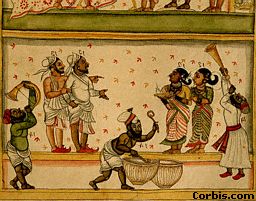
In Vedic times marriage was a sacrament.
It is so, even now.
There is a ritual called Saptapadi.
During this ritual the bridegroom
enters into an agreement with his newly married bride.
The following is a rough translation of some Mantras
that occur in Saptapadi Dampathya Sakhyam
invariably recited by the groom;
My life-mate you have become,
with seven steps taken,hand on toe,
Swerving not from companionship,
together shall we always be
together shall we resolve on the course to steer,
With our affection deep,liking mutial,
and minds of noble bent,
alike may our thinking be,
and alike,our ideas and ideals be.
Together shall we,
the bounties of wealth and food enjoy.
Together shall we carry out the duties enjoined,
For prosperity and progeny,
for us to achieve,
Come, join me,
Oh, the truthful one.
THE SACRAMENT OF MARRIAGE
Of all the sacraments,
Vivaha or marriage is considered
to be the most central one.
The scriptures rightly emphasise the
importance of the life of the house-holder.
The sacrament of marriage impresses
upon a person that earthly life is not to be despised;
rather it should be consciously accepted
and elevated to the level of spiritual experience.
Marriage is not a licence for indulgence,
but a human institution aiming at moderation in conjugal life
leading ultimately to the conquest of self.
It is essentially a fellow-ship between
a man and a woman who seek to live creately
in a partnership for the pursuit of the
four "Purusharthas"( aims of life :
i.e.Dharma ,Artha, Kaama and Moksha )
Besides the bride and the bride-groom,
there is a third party - DHARMA
(i.e. their joint religious duty )
through which only they have been united.
The most important steps of marriage are:-
- Kanya Daana: i.e gifting the bride to the
bride-groom by the legitimate guardian
- Vivaha-homa: Marriage offering in the sacred fire
- Panigrahana: Clasping the hand of the bride by the bride-groom
- Maangalya Dhaarana : Tying the wedding knot
- Saptapadi: Walking the seven steps
- Ashmaarohana: Mounting the stone
- Suryaalokana: Looking at the Sun who is the eternal witness
- Dhruva Darsana: Gazing at the Pole Star.
Panigrahana symbolises that the bride-groom
has taken over the responsibility of the bride.
Saptapadi is symbolic of prosperity and felicity.
The bride-groom enters into a sort of friendship
and promises unswerving companionship
of togetherness in all matters of
decision making with mutual friendship
and understanding within the frame-work of Dharma.
At the end of the ceremony,the bride passes
into the family of the bride-groom.
Marriage is said to be complete with it.
Ashmaarohana is mounting the stone and
represents stability and constancy.
For a translation of certain relevant Mantras see THE SEVEN STEPS.
Home
